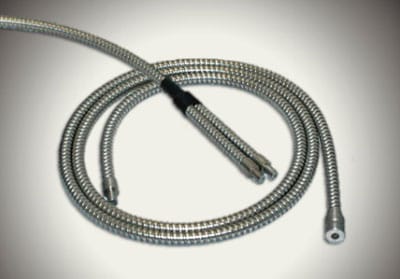
A fiber optic bundle, (also known as a light guide or light pipe), is a multiplicity of single optical fiber strands. When this multiplicity of fibers is randomly gathered, it is usually collected in a jacket (buffer, sheathing, housing) and held together at each end with epoxy to form an output or input source. To further support the bundle ends and secure the jacket, the gather of fibers is epoxied in a ferrule (end tip, bushing, connector). Once the ends are polished, the finished fiber optic bundle is used to transmit light from one location to another.
Fiber optic bundles are used in many applications, but the two most common uses of this fiber optic form are illumination and signal collection.
Fiber Optic Bundle Types

Using Oriented Fiber Bundles
Using a different special process, a multiplicity of single optical fibers is gathered AND their order is maintained. After the jacket and end tips are applied and the ends polished, this oriented bundle of fibers (image guide) can transmit an image. This is great for use in medical and industrial imaging applications (borescopes), especially when the image path is not straight.
Oriented bundles are almost always configured singularly, with the same geometry at both ends.
Randomly produced fiber optic bundles can be configured in a variety of ways, including:
- Single – two polished ends, one single transmission path.
- Bifurcated – one larger bundle (common end) is separated into two smaller bundles (the bifurcated end). Once the two bundles are separated, that section is called the bifurcated end.
Using bifurcated bundles, the input from two light sources can be merged into one output, or the output from one light source can be separated into two independent sources. A third configuration will launch the light source output into one of the bifurcated ends… the light will exit the common end, reflect off a surface, and return to be collected in the same common end, finally exiting the unoccupied leg of the bifurcation. This “Signal” will activate a sensor, used to open a gate, turn on a light, or some other low voltage application, mostly related to factory automation.
Other variations on this concept would be trifurcated, quadfurcated, and so on. (see Figure 1)
Fiber Bundle Geometries

Sometimes one end of a single fiber optic bundle will be circular, the other end any number of different configurations including rings, lines, panels, fans, half-moons, squares, hexes, and more. These different configurations can be used to emit specific light patterns, or collect light from different pattern inputs, and return the light to a sensor. Furcated bundles can also be configured into the same shapes mentioned above.
Different types of fibers (silica, flint, plastic and more) can all be packaged into fiber optic bundles, and can be comingled, but most often, fiber optic bundles are comprised of one fiber type.
The bundle configuration and optimal fiber type for a bundle are always dictated by the application. This approach assures the most cost effective solution.

